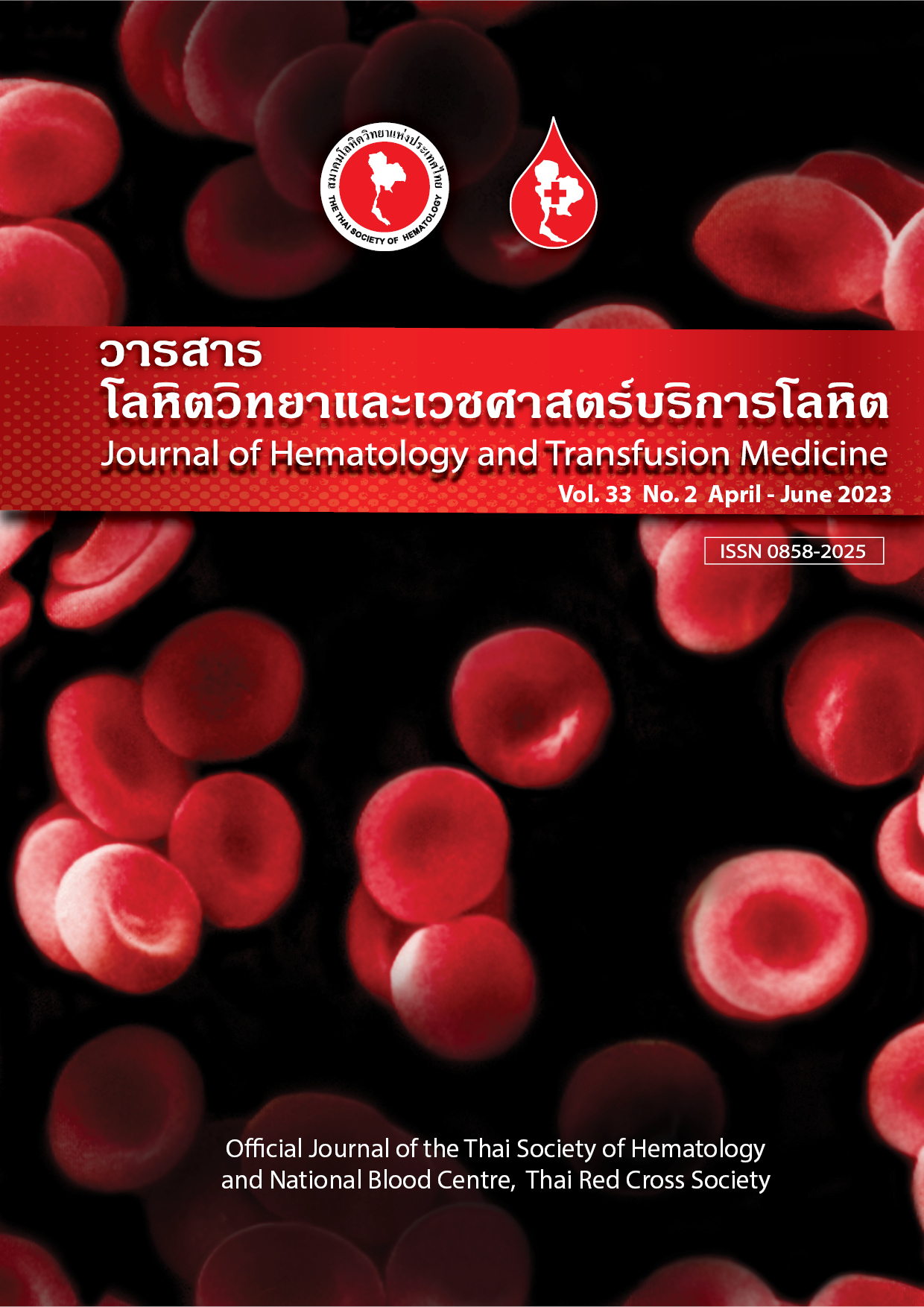Prevalence, causes and outcomes of thrombocytopenia among patients in medical intensive care units
Keywords:
thrombocytopenia, intensive care unit, platelet, medical intensive care unitAbstract
Objective: The study aimed to identify the prevalence, causes, outcomes and prognostic factors for survival of patients with thrombocytopenia in a medical ICU. Material and Methods: This comprised a retrospective study conducted at Maharaj Nakorn Chiang Mai Hospital. Data were collated from adult patients admitted to a medical ICU with a platelet count ≤ 100 x109/L from January 2016 to December 2019. Clinical characteristics, outcomes and data were analyzed to investigate the prognostic factors for survival. Results: Of 2,039 patients admitted to a medical ICU, thrombocytopenia was prevalent in 182 cases (8.9%). The most common cause of thrombocytopenia was infections (85%). Mean platelet count during the thrombocytopenic period and platelet nadir were
55.8±27.9 x109/L and 34.6±26.5 x109/L, respectively. Mean duration of thrombocytopenia was 11.9+4.1 days, and rate of bleeding complications and mortality were 30.7% and 67.0%, respectively. Survival analysis revealed that age ≥ 80 years (HR 1.99; 95%CI: 1.16-3.39, p = 0.012) and low nadir hemoglobin (Hb) (HR 0.88; 95%CI: 0.81-0.97, p = 0.01) were the variables significantly associated with increased mortality. Conclusion: The prevalence of thrombocytopenia in a medical ICU was 8.9% with a mortality of 67.0%. Infection was the most common cause. Age ≥ 80 years and low nadir Hb were associated with higher mortality rate.
Downloads
References
Greinacher A, Selleng K. Thrombocytopenia in the intensive care unit patient. Hematology Am Soc Hematol Educ Program. 2016;26:135-43.
Baughman RR, Lower EE, Flessa HC, Tollerud DJ. Thrombocytopenia in the intensive care unit. Chest. 1993;104:1243-7.
Crowther MA, Cook DJ, Meade MO, Griffith LE, Guyatt GH, Arnold DM, et al. Thrombocytopenia in medical-surgical critically ill patients: prevalence, incidence and risk factor. J Crit Care. 2015;20:348-53.
Moreau D, Timsit JF, Vesin A, Garrouste-Orgeas M, de Lassence A, Zahar JR, et al. Platelet count decline an early prognostic marker in critically ill patients with prolong ICU stays. Chest. 2007;131:1735-41.
Wang T, Liu Z, Wang Z, Duan M, Li G, Wang S, et al. Thrombocytopenia is associated with acute respiratory distress syndrome mortality rate. PLoS One. 2014;9:e94124.
Hjorleifsson E, Sigurdsson MI, Gudmundsdottir BR, et al. Prediction of survival in patients suspected of disseminated intravascular coagulation. Acta Anaesthesiol Scand. 2015;59:870-80.
Stachon A, Segbers E, Holland-Letz T, Sigurdsson GH, Onundarson PT. Nucleated red blood cells in the blood cells in the blood of material intensive care patients indicate increased mortality risk: A prospective cohort study. Crit Care. 2007;11:R62.
de Moura Monteiro Junior JG, Torres DOC, Cleide M, de Brito Ramos TM, Alves ML, Filho WJN, et al. Nucleated red blood cells as predictors of all-cause mortality in cardiac intensive care unit patients. PLoS One. 2015;10:e0144259.
Filho SLAP, Lima LMB, Dantas GLA, de Almeida Silva D, de Matos Rolim V, de Oliveira Filho AMP, et al. Prognostic factors among critically ill patients with community-acquired acute bacterial meningitis and acute kidney injury. Rev Bras Tee Intensive. 2018;30:153-9.
Serdar A, Haji-Michael P, Arnaldo M, Suter P, Levi M, Vincent JL. Time course of platelet counts in critically ill patients. Crit Care Med. 2012;30:753-6.
Sukmark T, Lumlertgul N, Praditpornsilpa K, Tungsanga K, Eiam- Ong S, Srisawat N. THAI-ICU score as a simplified severity score for critical ill patients in a resource limited setting: Result from SEA-AKI study group. Crit Care. 2020;55:56-63.
Shankar-Hari M, Philip GS, Levy ML, Liu VX, Deutschman CS, Angus DC, et al. Developing a new definition and assessing new clinical criteria for septic shock for the International Consensus Definitions for Sepsis and Septic Shock (Sepsis3). JAMA. 2016;315:775-87.
Wada H, Thachil J, Di Nisio M, Mathew P, Kurosawa S, Gando S, et al. Guidance for diagnosis and treatment of DIC from harmonization of the recommendations from three guidelines. J Thromb Haemost. 2013;11:761-7.
Lim SY, Jeon EJ, Kim HJ, Jeon K, Um SW, Koh WJ, et al. The incidence, causes, and prognostic significance of new-onset thrombocytopenia in intensive care units: A prospective cohort study in Korean Hospital. J Korean Med Sci. 2012;27:1418-23.
Menard CE, Kumar A, Houston DS, Turgeon AF, Rimmer E, Houston BL, et al. Evolution and impact of thrombocytopenia in septic shock: A retrospective cohort study. Crit Care Med. 2019;47:558-65.
Warkentin TE, Sheppard JAI, Sigouin CS, Kohlmann T, Eichler P, Greinacher A. Gender imbalance and risk factor interactions in heparin-induced thrombocytopenia. Blood. 2006;108:2937-41.
Greinacher A, Selleng S. How I evaluate and treat thrombocytopenia in the intensive care unit patient. Blood. 2016;128:3032-42.
Grafeneder J, Krychtiuk KA, Buchtele N, Schoergenhofer C, Gelbenegger G, Lenz M, et al. The ISTH DIC score predicts outcome in non-septic patients admitted to a cardiovascular intensive care unit. Eur J Intern Med. 2020;79:37-42.
Tao Z, Xu J, Chen W, Yang Z, Xu X, Liu L, et al. Anemia is associated with severe illness in COVID-19: A retrospective cohort study. J Med Virol. 2021;93:1478-88.
Song X, Liu XY, Wang HR, Guo XY, Kashani KB, Ma PL. Association between anemia and ICU outcomes. Chinese Med J. 2021;134:1744-6.
Fountain EM, Arepally GM. Etiology and complications of thrombocytopenia in hospitalized medical patients. J Thromb Thrombolysis. 2017;43:429-36.
Arnold DM, Lauzier F, Albert M, Williamson D, Li N, Zarychanski R, et al. The association between platelet transfusions and bleeding in critically ill patients with thrombocytopenia. Res Pract Thromb Haemost. 2017;1:103-11.
Levi M, Sivapalaratnam S. Haemostatic abnormalities in critically ill patients. Intern Emerg Med. 2015;10:287-96.
Downloads
Published
Issue
Section
License
Copyright (c) 2023 Journal of Hematology and Transfusion Medicine

This work is licensed under a Creative Commons Attribution-NonCommercial-NoDerivatives 4.0 International License.



